Welcome to our comprehensive guide on Eleocharis Pusilla care. Whether you’re a beginner or an experienced aquarist, we’re here to provide you with all the information you need to properly care for and grow Eleocharis Pusilla in your aquarium.
With its unique grass-like appearance and the ability to create a lush carpet effect, this popular aquarium plant can enhance the beauty of your tank.
Let’s dive in and discover the secrets to successful Eleocharis Pusilla care.
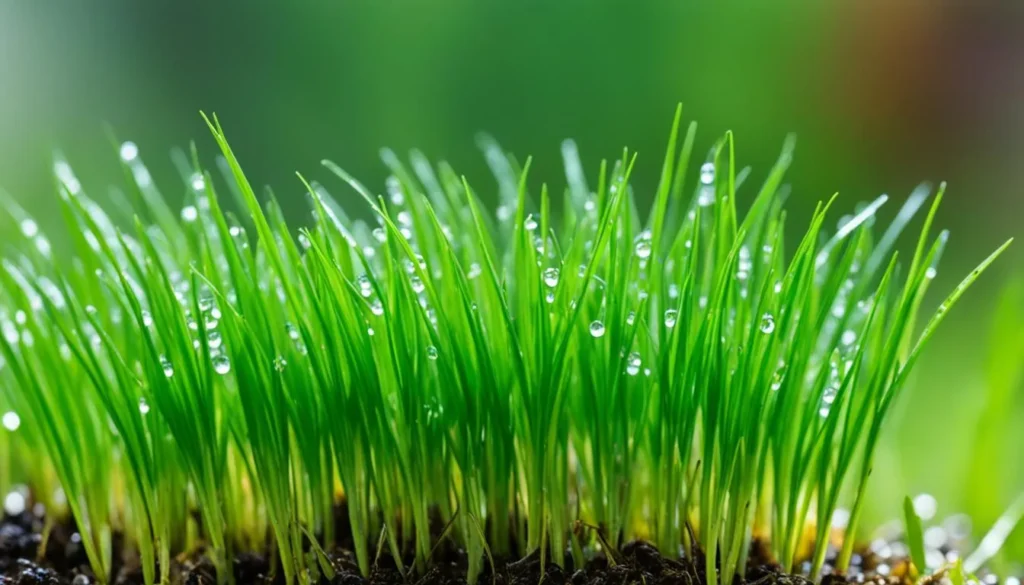
Key Takeaway
- Proper care is essential for the health and growth of Eleocharis Pusilla.
- Lighting, substrate, water parameters, and CO2 supplementation are key to ensuring optimal growth.
- Regular trimming and maintenance are necessary to keep the Eleocharis Pusilla carpet in good condition.
- Choosing compatible tank mates and controlling algae and pests are important for maintaining a healthy aquarium environment.
- Eleocharis Pusilla can be propagated by separating runners or using tissue culture methods.
Quick Stats
| Attribute | Details |
| Family Name | Cyperaceae |
| Origin | Cosmopolitan distribution, found in various regions worldwide |
| Height | 2-6 cm (0.8-2.4 inches), can grow taller under lower light conditions |
| pH Range | 6.0 – 7.5 |
| CO2 Requirement | Low to Moderate |
| Growth Rate | Moderate to Fast |
| Care Level | Easy to Moderate |
| Color Form | Bright Green |
| Water Conditions | 18-26°C (64-79°F), adaptable to a wide range of water hardness |
| Max Size | Forms a dense carpet, individual blades can reach up to 6 cm |
| Lighting | Moderate to High |
| Supplements | CO2 supplementation enhances growth; benefits from liquid fertilizers and iron |
| Placement | Foreground |
| Propagation | By runners |
What Is Eleocharis Pusilla?
Eleocharis pusilla, also known as dwarf hair grass, is a popular aquarium plant often used to create a lush carpet-like appearance in aquascapes.
It belongs to the Cyperaceae family and is native to wetland areas in Australia and New Zealand.
Eleocharis Pusilla features thin, grass-like leaves that grow densely and can reach a height of about 2-3 inches.
It is a versatile plant that can be placed in the foreground or midground of the aquarium.
Its compact size and unique growth pattern make it an ideal choice for nano tanks or as a carpeting plant in larger setups.
With the right care, Eleocharis Pusilla can thrive and create a stunning underwater landscape in your aquarium.
Natural Habitat And Origin
Eleocharis pusilla, commonly known as Dwarf Spike Rush or Eleocharis parvula ‘Mini’, is native to various regions worldwide, including North America, South America, Europe, Asia, and Africa.
It typically grows in wet or marshy habitats such as marshes, bogs, riversides, and shallow waters with sandy or gravelly substrates.
In its natural habitat, Dwarf Spike Rush forms dense mats or carpets along the water’s edge, providing habitat and shelter for small aquatic organisms.
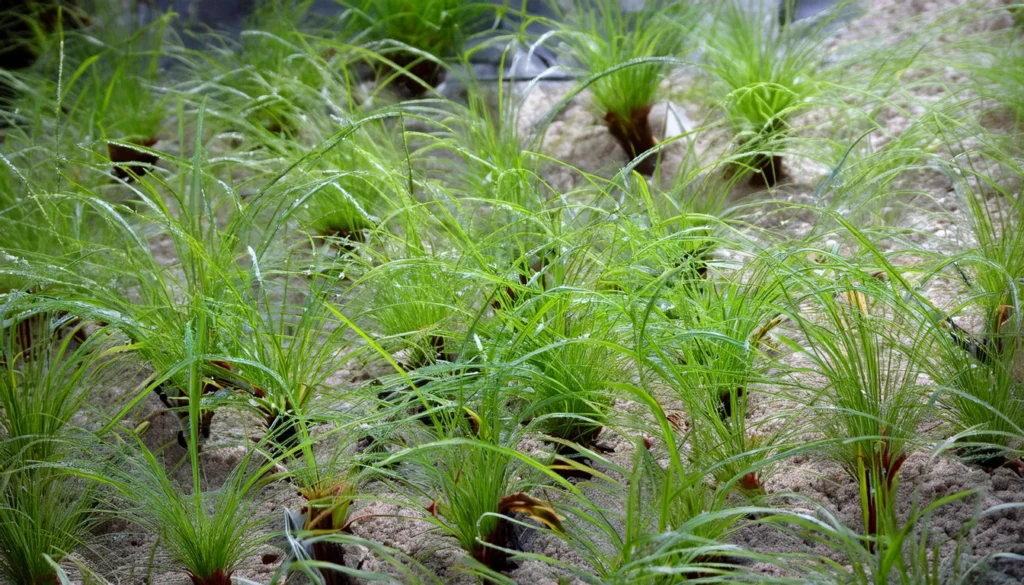
Physical Characteristics
- Height: It typically grows to a height of 3 to 5 centimeters (1.2 to 2 inches), making it one of the smallest species in the Eleocharis genus.
- Leaf Structure: The leaves are thin and grass-like, with a bright green coloration. They are typically narrow and linear, resembling blades of grass.
- Growth Form: Dwarf Spike Rush forms dense, low-lying mats when planted in groups. Its growth pattern is characterized by spreading runners that produce new plantlets along the substrate.
- Root System: It has a fibrous root system that anchors the plant in the substrate. The roots are relatively delicate and spread horizontally, helping the plant to establish and spread across the aquarium floor.
- Texture: The foliage of Dwarf Spike Rush has a fine texture, adding visual interest and depth to the aquascape. It creates a natural-looking carpet effect when planted densely.
The Role Of Lighting In Eleocharis Pusilla Growth
- For Eleocharis Pusilla, medium to high light intensity is recommended to ensure proper growth and prevent the plant from becoming spindly or etiolated. Adequate lighting promotes healthy photosynthesis, resulting in lush and vibrant growth of Eleocharis Pusilla.
- LED lights are a popular choice for aquarium lighting due to their energy efficiency and ability to provide the right spectrum of light for photosynthesis. LED lights can deliver the necessary intensity and color spectrum required for Eleocharis Pusilla to thrive.
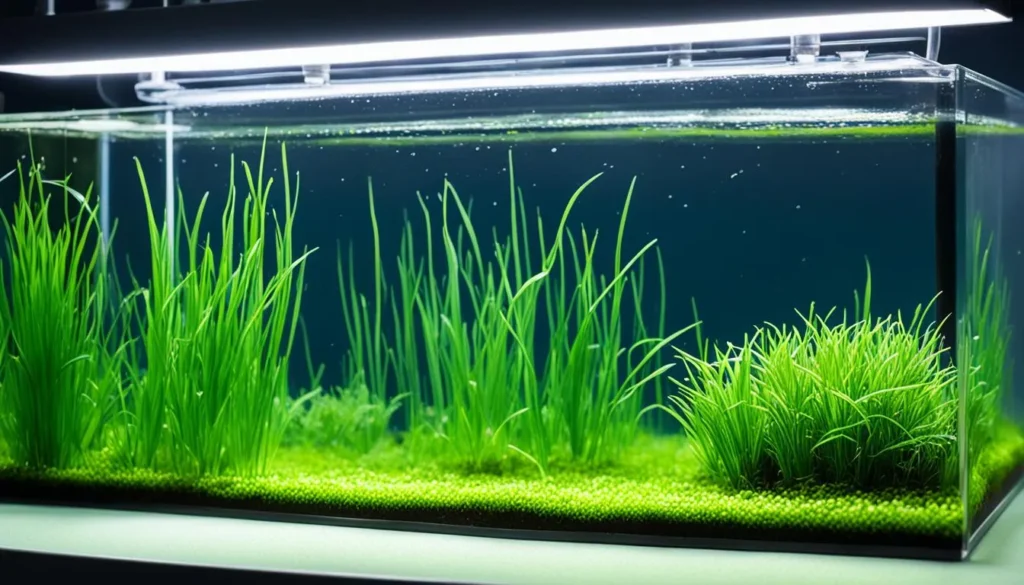
The Importance Of Water Parameters In Eleocharis Pusilla Care
- Maintaining proper water parameters is crucial for the health and growth of Eleocharis Pusilla. This plant thrives in slightly acidic to neutral water with a pH range of 6.5 to 7.5.
- The temperature range should be between 50-83°F to provide optimal conditions for growth. It’s also important to monitor water hardness levels, typically between 4-12 dGH, to ensure the plants have access to essential minerals.
- Regular water testing using a quality test kit will allow you to maintain stable water conditions and prevent any imbalances that could negatively impact the growth and health of Eleocharis pusilla.
Temperature Parameters
- Dwarf Spike Rush (Eleocharis pusilla) thrives within a temperature range typical for tropical aquarium plants. Here are the optimal temperature parameters:
- Temperature: Maintain the water temperature between 20°C to 28°C (68°F to 82°F) for healthy growth. This range mimics the plant’s natural habitat conditions and supports vigorous growth and propagation.
- Consistency in temperature is crucial to prevent stress and ensure the plant’s well-being. Use a reliable aquarium heater and monitor water temperature regularly to maintain stability.
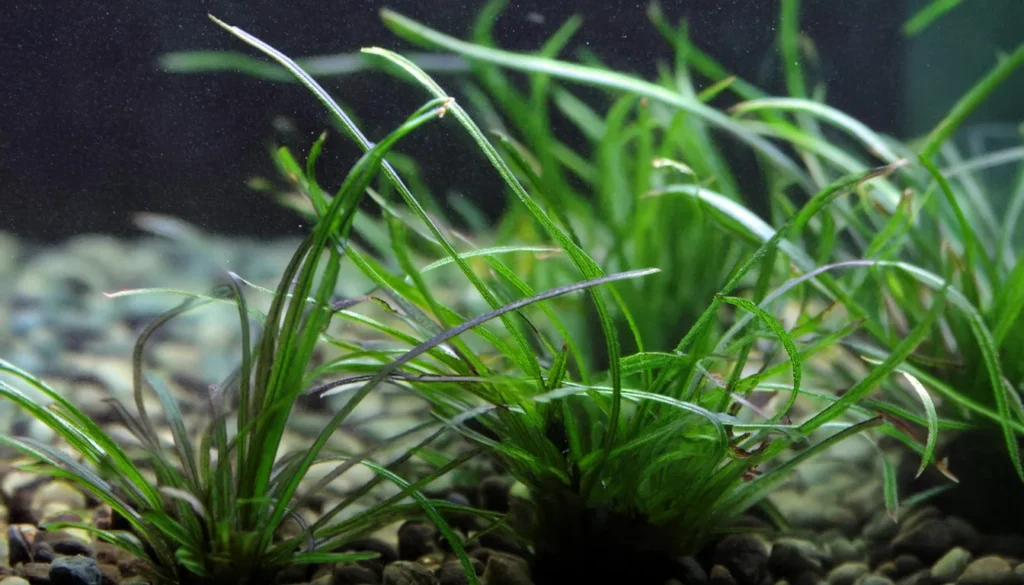
The Ideal Substrate For Eleocharis Pusilla
- Selecting the right substrate is essential for the growth and establishment of Eleocharis Pusilla in your aquarium. This plant prefers a fine to medium-grade substrate that allows its roots to take hold and spread quickly. Coarse sand is suitable as it provides stability and good drainage while allowing the roots to penetrate easily.
- Additionally, incorporating a nutrient-rich substrate, such as aqua soil or adding a layer of nutrient-rich dirt beneath the sand, can provide essential nutrients for the plants. When setting up your aquarium, ensure the substrate is properly prepared and level to create a suitable environment for Eleocharis Pusilla to thrive.
Placement Option
- Foreground Planting: Dwarf Spike Rush is commonly used as a foreground plant due to its small size and carpeting growth habit. Plant it in the front section of the aquarium to create a lush carpet effect that adds depth and visual appeal.
- Midground Accent: While Dwarf Spike Rush is primarily a foreground plant, it can also be used as a midground accent to break up larger expanses of substrate or to transition between foreground and background plants. Plant it in small clusters or patches to add texture and dimension to the midground area.
- Under Hardscape Features: Dwarf Spike Rush can be planted around hardscape features such as rocks, driftwood, or aquarium decorations. This helps soften the edges of the hardscape and creates a natural transition between the hardscape and the substrate.
- In Habitat Zones: Mimic Dwarf Spike Rush’s natural habitat by planting it in areas with moderate to high lighting and nutrient availability. Create open spaces in the substrate to allow the plants to spread and form a dense ca
RELATED: The Red Spectrum: Captivating Cryptocoryne Wendtii Wendtii
Recommended Tank Size
- Nano Tanks: Dwarf Spike Rush can thrive in smaller aquariums, such as nano tanks with capacities ranging from 5 to 20 gallons. These smaller tanks are suitable for creating compact foreground carpets or midground accents.
- Small to Medium Tanks: For a more expansive carpet effect or to cover larger areas of the aquarium floor, consider using Dwarf Spike Rush in small to medium-sized tanks ranging from 20 to 50 gallons.
- Large Tanks: In larger aquariums exceeding 50 gallons, Dwarf Spike Rush can still be used effectively to create lush carpeting, particularly in the foreground or midground sections. Larger tanks offer more space for the plants to spread and create a visually striking carpet effect.
Suitable Tank Mates
- Small Fish: Small, peaceful fish species like tetras, rasboras, danios, guppies, and small catfish can complement Dwarf Spike Rush well. Avoid species known for digging or uprooting plants.
- Shrimp: Neocaridina and Caridina shrimp species, such as Cherry Shrimp and Crystal Red Shrimp, are excellent tank mates for Dwarf Spike Rush. They help keep the aquarium clean and rarely disturb the plants.
- Snails: Snails like Nerite Snails and Malaysian Trumpet Snails can be beneficial tank mates, as they consume algae and debris without damaging the plants.
- Dwarf Crayfish: If you have a larger aquarium with sufficient hiding places, Dwarf Crayfish can coexist with Dwarf Spike Rush. Ensure that the crayfish cannot access the plant roots to prevent damage.
- Bottom Dwellers: Small bottom-dwelling species like Corydoras catfish and Otocinclus catfish are compatible with Dwarf Spike Rush. They help clean the substrate and add activity to the lower regions of the aquarium.

Nutritional Requirements
- Macronutrients: Nitrogen (N), phosphorus (P), and potassium (K) are essential macronutrients for plant growth. These nutrients are often available in aquarium water through fish waste, decaying organic matter, and regular water changes. If necessary, you can supplement with aquarium fertilizers containing these macronutrients.
- Micronutrients: Iron (Fe), manganese (Mn), and other trace elements are important micronutrients for plant health. These nutrients are often present in trace amounts in tap water and fish food. If deficiencies are observed, you can supplement with micronutrient-rich aquarium fertilizers.
- Carbon (CO2): While Dwarf Spike Rush can grow without supplemental CO2, providing a source of carbon dioxide can enhance growth and promote vibrant green coloration. CO2 injection systems or liquid carbon supplements can be used to supplement carbon in planted aquariums.
- Light: Light is essential for photosynthesis, the process by which plants convert light energy into chemical energy to fuel growth. Provide moderate to high-intensity lighting for at least 8 to 10 hours per day to support healthy photosynthesis in Dwarf Spike Rush.
Cultivation Tips
- Lighting: Provide moderate to high-intensity lighting to mimic the plant’s natural habitat conditions. Aim for a lighting duration of 8 to 10 hours per day to support photosynthesis and healthy growth.
- Substrate: Use a nutrient-rich substrate with fine grains to anchor the delicate roots of Dwarf Spike Rush. Ensure a depth of at least 2 to 3 inches to allow for proper root penetration and stability.
- CO2 and Nutrients: Supplement with CO2 and liquid fertilizers to provide essential nutrients for robust growth. Dwarf Spike Rush benefits from a balanced supply of nitrogen, phosphorus, potassium, iron, and micronutrients.
- Planting Density: Plant Dwarf Spike Rush in dense clusters or mats to encourage carpet-like growth. Space individual plants about 1 to 2 centimeters apart to achieve full coverage of the substrate.
- Propagation: Dwarf Spike Rush propagates readily through runners, producing new plantlets that can be separated and replanted. Encourage propagation by regularly thinning out overcrowded areas and replanting new plantlets.
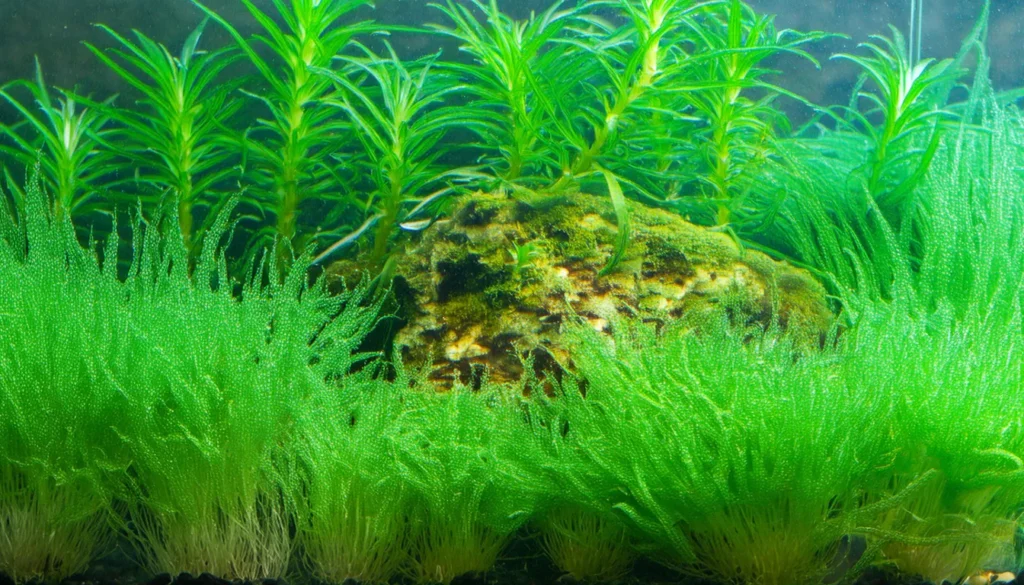
Eleocharis Pusilla Propagation Techniques
- Propagating Eleocharis Pusilla is an exciting way to expand your aquarium carpet and create a lush and vibrant underwater landscape. You can use several methods to propagate this plant and promote continuous growth in your tank.
- One propagation method is separating runners and planting them in new areas of the aquarium. Eleocharis Pusilla naturally spreads and sends out runners, which can be carefully separated from the parent plant and replanted. This allows the plant to expand and form new growth points, creating a denser carpet over time.
- Another propagation method is through tissue culture. In tissue culture, clean and disease-free plants are readily available for starting new growth. This method ensures you have healthy plants to introduce into your aquarium without worrying about pests or diseases.
Benefits Of Planting Eleocharis Pusilla
- Aesthetic Enhancement: Dwarf Spike Rush creates a lush carpet effect in the foreground of the aquarium, adding visual appeal and depth to the aquascape. Its fine texture and bright green coloration complement various aquatic layouts.
- Oxygenation: Like other aquatic plants, Dwarf Spike Rush contributes to oxygenating the water through photosynthesis. This helps maintain optimal oxygen levels for fish and other aquatic inhabitants.
- Water Filtration: The dense growth of Dwarf Spike Rush helps absorb excess nutrients, pollutants, and organic waste from the water column. This aids in water filtration and improves water quality, reducing the risk of algae blooms and maintaining a healthy aquatic environment.
- Habitat Creation: Dwarf Spike Rush provides shelter and hiding places for small fish, shrimp, and other aquatic organisms. It mimics natural habitats and creates a conducive environment for breeding and foraging activities.
- Preventing Algae Growth: By outcompeting algae for nutrients and light, Dwarf Spike Rush helps suppress algae growth in the aquarium. Its dense growth shades the substrate, reducing available light for algae to thrive.
- Erosion Control: The root system of Dwarf Spike Rush helps stabilize the substrate, reducing the risk of erosion in the aquarium. This is particularly beneficial in setups with sloped substrates or areas prone to substrate displacement.

Addressing Common Issues With Eleocharis Pusilla
- Like any aquarium plant, Eleocharis Pusilla is susceptible to algae growth and pests. To prevent algae from overtaking the carpet, proper water parameters, lighting levels, and nutrient balance must be maintained. Regular water changes, mechanical removal of algae, and the use of algae-controlling products can help keep algae growth in check.
- In terms of pests, common issues include snail infestations and plant-eating insects. Regular monitoring, manual removal, and the use of natural pest control methods, such as introducing beneficial aquatic animals or using organic pest control products, can help address pest issues without harming the Eleocharis Pusilla carpet.
Conclusion
Eleocharis Pusilla, also known as dwarf hairgrass, is a stunning and versatile aquarium plant that can bring life and beauty to your tank.
By following the guidelines and tips provided in this comprehensive care guide, you can successfully grow and maintain a lush carpet of Eleocharis Pusilla in your aquarium.
Proper care and maintenance are crucial for the health and vitality of Eleocharis Pusilla.
This includes providing the plant with the right lighting, substrate, and water parameters.
Regular trimming and addressing common issues such as algae and pests are also important for maintaining a thriving carpet.
Whether you’re a beginner or an experienced aquarist, this care guide has provided you with all the information you need to ensure the success of Eleocharis Pusilla in your aquarium.
Enjoy the process of creating and caring for this captivating plant, and witness the transformation of your tank into a vibrant underwater scape.
Frequently Asked Questions
How Does Eleocharis Pusilla Adapt To Fluctuating Water Levels In Its Natural Habitat, And How Can This Be Mimicked In A Controlled Environment?
Eleocharis pusilla thrives in environments with varying water levels, often found in wetlands that experience seasonal flooding and drying periods.
In its natural habitat, it has adapted to survive these fluctuations by developing a robust root system that anchors it in place and stores nutrients.
To mimic these conditions in a controlled environment, such as an aquarium or garden, periodically adjust water levels or allow the soil to dry out slightly before rewatering.
This approach encourages the development of a strong root system and can stimulate more vigorous growth.
Can Eleocharis Pusilla Be Used In Phytofiltration Applications, And What Are Its Benefits Over Other Aquatic Plants?
Eleocharis pusilla is an excellent candidate for phytofiltration due to its dense growth and extensive root system, which helps in the absorption of nutrients and pollutants from the water.
Compared to larger aquatic plants, its small size and fast growth rate make it ideal for use in smaller water bodies or in systems where space is limited.
Additionally, its ability to tolerate a wide range of water conditions and its effectiveness in nutrient uptake can often surpass that of larger, less adaptable species, making it a valuable addition to water purification setups.
What Specific Challenges Are Faced When Cultivating Eleocharis Pusilla In Aquascapes, And How Can These Be Overcome?
One of the primary challenges in cultivating Eleocharis pusilla in aquascapes is ensuring even growth and preventing algae overgrowth, which can be exacerbated by excessive light or nutrients.
To overcome these challenges, it’s essential to provide moderate lighting, consistent CO2 supplementation (if applicable), and regular maintenance to remove any algae that do develop.
Additionally, trimming the plants can encourage bushier growth, helping to achieve a more aesthetically pleasing, dense carpet effect.
How Does The Genetic Diversity Within Eleocharis Pusilla Populations Affect Its Cultivation And Conservation Strategies?
Genetic diversity within Eleocharis pusilla populations plays a crucial role in its adaptability to different environmental conditions, resistance to pests and diseases, and overall vitality.
Understanding and preserving this genetic diversity is essential for successful cultivation and conservation efforts.
Strategies may include sourcing plants from a variety of locations to maintain genetic diversity in cultivated settings and focusing on habitat preservation to protect natural populations.
Additionally, research into the specific genetic traits that contribute to desirable characteristics can inform selective breeding programs.
What Role Does Eleocharis Pusilla Play In Its Ecosystem, And How Can This Influence Its Use In Habitat Restoration Projects?
Eleocharis pusilla plays several vital roles in its ecosystem, including stabilizing soil and sediment, providing habitat and food for various microfauna, and contributing to the overall biodiversity of wetland areas.
Its dense growth and root system can help prevent erosion and improve water quality by filtering pollutants.
These ecological benefits make it an attractive option for habitat restoration projects, particularly in wetlands and other aquatic environments.
When used in restoration, it’s important to consider the plant’s natural growing conditions and ecological role to ensure that its introduction supports the overall goals of the project, such as increasing biodiversity or improving water quality.
- Unveiling The Wonders Of Riccia Fluitans In Aquascapes - August 7, 2024
- Vallisneria Gigantea Var. Guide To Care And Cultivation At Home - July 31, 2024
- Vesicularia Dubyana Care & Growth Guide Tips For Beginner Gardeners - July 30, 2024
